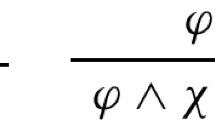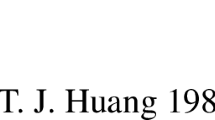Abstract
The paper argues that Hungarian negative sentences contain a NegP, a functional projection inside IP. The spec-head configuration requirement of the Neg-Criterion is satisfied by a null operator at S-structure. Negative phrases surfacing in different sentence positions enter into a representational chain (attested as Negative Concord), or a derivational chain. Negative chains have a member of them adjoined to Spec NegP, as a result of which they acquire sentential scope. Sem is not an equivalent of nem but the negative counterpart of is 'also'; sem-phrases occupy the specifier of a functional projection above FP.
Similar content being viewed by others
References
Acquaviva, P. 1993. The logical form of negation: a study of operator-variable structures in syntax. PhD dissertation, Scuola Normale Superiore, Pisa.
Acquaviva, P. 1995. Operator composition and the derivation of negative concord., ms, University College, Dublin.
Bayer, J. 1996. Directionality and logical form. Kluwer, Dordrecht.
Belletti, A. 1990. Generalized verb movement. Rosenberg & Sellier, Torino.
Brody, M. 1990. Some remarks on the focus field in Hungarian. UCL Working Papers, 2: 201–25.
Brody, M. 1995a. Focus and checking theory. In: Kenesei, I. (ed.): Approaches to Hungarian Vol. 5, 29–43. JATE, Szeged.
Brody, M. 1995b. Lexico-logical form. MIT Press, Cambridge MA.
Choe, H.S. 1989. Restructuring parameters and scrambling in Korean and Hungarian. In: Marácz, L.-Muyskens, P. (eds): Configurationality, 267–92. Foris, Dordrecht.
É. Kiss, K. 1987. Configurationality in Hungarian. Reidel, Dordrecht.
É. Kiss, K. 1992. Move-alpha and scrambling in Hungarian In: Kenesei, I.-Pléh, Cs. (eds): Approaches to Hungarian Vol. 4, 67–98. JATE, Szeged.
Grimshaw, J. 1991. Extended projections, ms, Brandeis University.
Haegeman, L. 1995. The syntax of negation. CUP, Cambridge.
Haegeman L.-Zanuttini, R. 1991. Negative heads and the Neg criterion. In: The Linguistic Review 8: 233–51.
Horváth, J. 1981. Aspects of Hungarian syntax and the theory of grammar. PhD dissertation, UCLA, Los Angeles CA.
Horváth, J. 1986. Focus in the theory of grammar and the syntax of Hungarian. Foris, Dordrecht.
Kenesei, I. 1984. On what really figures in a non-configurational language. In: Groninger Arbeiten zur Germanistischen Linguistik 24: 28–54.
Kenesei, I. 1986. On the logic of word-order in Hungarian. In: Abraham, W.-de Meij, S. (eds): Topic, focus and configurationality, 143–59. John Benjamins, Amsterdam.
Klima, E. 1964. Negation in English. In: Fodor, J.-Katz, J. (eds): The structure of language, 246–323. Prentice Hall, Englewood Cliffs NJ.
Laka, I. 1990. Negation in syntax: on the nature of functional categories and projections. PhD dissertation, MIT.
Lipták, A. 1996. AgrP projections and expletives in Hungarian: what long focus-movements can reveal, ms, József Attila University, Szeged.
Marácz, L. 1989. Asymmetries in Hungarian. Doctoral dissertation, Rijksuniversität Groningen.
Marácz, L. 1990. V-movement in Hungarian: a case of minimality. In: Kenesei, I. (ed.): Approaches to Hungarian, Vol 3, 1–27. JATE, Szeged.
Marácz, L. 1992. Some notes on long verb movement in Hungarian. ms, University of Groningen.
Newson, M. 1994. Negation, double negation and optimality theory. In: The Even Yearbook 1994, 87–136. ELTE, Budapest.
Ouhalla, J. 1990. Sentential negation, relativised minimality and the aspectual status of auxiliaries. In: The Linguistic Review 7: 183–231.
Papp, Sz. 1996. The acquisition of Hungarian negation, wh-questions and focus by L1 and L2 adult learners, ms, University of Edinburgh.
Piñón, C. 1992. Heads in the focus field. In: Kenesei, I.-Pléh, Cs. (eds): Approaches to Hungarian Vol. 4, 99–122. JATE, Szeged.
Pollock, J.-Y. 1989. Verb movement, UG and the structure of IP. In: Linguistic Inquiry 20: 364–424.
Progovac, L. 1993. Negation and comp. In: Rivista di Linguistica 5: 329–247.
Puskás, G. 1992. The wh-criterion in Hungarian. In: Rivista di Grammatica Generativa 17: 141–86.
Puskás, G. 1994. Sentential negation in Hungarian. In: Rivista di Linguistica, 6: 57–90.
Puskás, G. 1996a. A split CP approach: evidence from Hungarian. In: GenGenP 3,2: 1–12.
Puskás, G. 1996b. Word-order in Hungarian: the syntax of A′-positions. Doctoral dissertation, University of Geneva.
Rizzi, L. 1990a. Relativized minimality. MIT Press, Cambridge MA.
Rizzi, L. 1990b. Speculations on verb second. In: Mascaró, J.-Nespor, M. (eds): Grammar in progress, GLOW essays for Henk van Riemsdijk, 375–86. Foris, Dordrecht.
Rizzi, L. 1991. Residual verb second and the wh-criterion. Technical reports in formal and computational linguistics 2. Université de Genève.
Rizzi, L. 1995. The fine structure of the left periphery. ms, Université de Genève.
Tóth, I. 1995. Negative polarity licensing in Hungarian, ms, József Attila University, Szeged.
Zanuttini, R. 1989. Syntactic properties of sentential negation: A comparative study of romance languages. Doctoral dissertation, University of Pennsylvania.
Zanuttini, R. (1997.) Negation and verb movement. In: L. Haegeman (ed.): The new comparative syntax, 214–45. Longman, London.
Author information
Authors and Affiliations
Corresponding author
Rights and permissions
About this article
Cite this article
Puskás, G. On the Neg-Criterion in Hungarian. Acta Linguistica Hungarica 45, 167–213 (1998). https://doi.org/10.1023/A:1009613125594
Issue Date:
DOI: https://doi.org/10.1023/A:1009613125594




